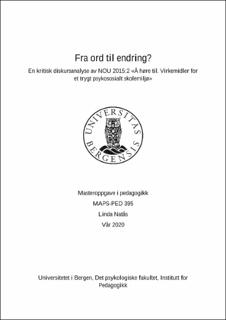| dc.contributor.author | Natås, Linda | |
| dc.date.accessioned | 2021-09-28T23:55:00Z | |
| dc.date.available | 2021-09-28T23:55:00Z | |
| dc.date.issued | 2020-05-30 | |
| dc.date.submitted | 2021-09-28T22:00:06Z | |
| dc.identifier.uri | https://hdl.handle.net/11250/2785835 | |
| dc.description.abstract | Mobbefenomenet blant barn og unge har vært, og er, et gjennomgangstema i utdanningspolitikken så vel som i det norske samfunnet. Debatten dreier seg i stor grad om hvordan problemet skal håndteres og motvirkes. Nulltoleranse mot mobbing har vært lansert, og antimobbeprogrammer utviklet og implementert. Det underliggende, hvordan selve mobbebegrepet blir fremstilt og forstått, er ikke utforsket i like stor grad som det psykologiske perspektivet på mobbing. Jeg gjennomførte en kritisk diskursanalyse av det utdanningspolitiske dokumentet NOU 2015:2 «Å høre til. Virkemidler for et trygt psykososialt skolemiljø», med problemstillingen: Hvordan forstås/fremstilles mobbing i norske utdanningspolitiske dokumenter? NOU 2015:2 ble valgt som datamateriale på bakgrunn av dokumentets sentrale og overgripende funksjon i arbeidet mot mobbing. Med Foucaults syn på makt som et overordnet perspektiv, og bruk av Faircloughs analysemodell for kritisk diskursanalyse, ble to diskurser om mobbing identifisert i NOU’en: en diskurs om trygghet og en diskurs om mangfold. Analysen avdekket også en dominans hos diskursen om trygghet som fremstår som en hegemonisk diskurs. Innenfor trygghetsdiskursen baseres forståelsen av mobbing på adferdsproblemer, med elementer av system og kontroll for forebygging og håndtering. Diskursen om mangfold, fremstår i NOU’en som en «annenrangs» diskurs om mobbing, og synes å bygge på forståelse av mobbing som et mer sosialt og komplekst problem. I mangfoldsdiskursen er prosesser som inkludering, tilhørighet, sosial og emosjonell kompetanse sentrale elementer i håndtering og forebygging av mobbefenomenet. Til tross for tilstedeværelse av to diskurser om mobbing i NOU 2015:2, argumenterer jeg for at den hegemoniske diskursens dominans og overherredømme fører til en del ideologiske konsekvenser som preger den sosiale praksis. Denne studien bidrar også til diskusjon om de forslagene som ble fremstilt i NOU 2015:2 har ført til endringer i hvordan fenomenet blir beskrevet og forstått. | |
| dc.description.abstract | The phenomenon of bullying among children and youth is a debated topic in the education politics as well as the Norwegian society. The debate is mostly about prevention and approach to handle the problem. A zero-tolerance policy towards bullying has been launched, and anti-bullying programs has been developed and implemented. How the term of bullying is being presented and understood is not yet explored to the same degree as the psychological perspective of bullying. I completed a critical discourse analysis of the education political document NOU 2015:2 “To belong. Methods for a safe psychosocial school environment”, with the topic question: "How is bullying understood/presented in Norwegian education political documents”? The NOU 2015:2 was chosen as data material due to its central function in the work against bullying. With Foucault’s view on power as an executive perspective, and the use of Fairclough's model for critical discourse analysis, two discourses about bullying were identified in the NOU: one discourse about safety, and one discourse about diversity. The analysis uncovered a dominance for the discourse about safety which therefor appears as a hegemonic discourse. The understanding of bullying within the discourse of safety is based on a behavioral problem, with elements of order and control for prevention and handling. The discourse about diversity in the NOU appears to be a “second rank” discourse about bullying. It seems to be building on the understanding of bullying as a social and complex problem. Human processes as inclusiveness, belongingness, social and emotional competence are central elements in how the phenomenon of bullying is perceived and explained in the discourse of diversity. Despite the existence of two discourses about bullying in NOU 2015:2, I argue that the hegemonic discourse’s dominance and supremacy leads to some ideological consequences that affect the social practice. This study contributes also to a discussion of the suggestions that were presented in NOU 2015:2 has led to any change in the way the phenomena is described and understood. | |
| dc.language.iso | nob | |
| dc.publisher | The University of Bergen | |
| dc.rights | Copyright the Author. All rights reserved | |
| dc.subject | adferd | |
| dc.subject | diskursanalyse | |
| dc.subject | mangfold | |
| dc.subject | trygghet | |
| dc.subject | tilhørighet | |
| dc.subject | inkludering | |
| dc.subject | Mobbing | |
| dc.title | Fra ord til endring? En kritisk diskursanalyse av NOU 2015:2 "Å høre til. Virkemidler for et trygt psykososialt skolemiljø". | |
| dc.type | Master thesis | |
| dc.date.updated | 2021-09-28T22:00:06Z | |
| dc.rights.holder | Copyright the Author. All rights reserved | |
| dc.description.degree | Masteroppgave i pedagogikk | |
| dc.description.localcode | PED395 | |
| dc.description.localcode | MAPS-PED | |
| dc.subject.nus | 724112 | |
| fs.subjectcode | PED395 | |
| fs.unitcode | 17-42-0 | |
